|
Philosophers
Mortimer Adler Rogers Albritton Alexander of Aphrodisias Samuel Alexander William Alston Anaximander G.E.M.Anscombe Anselm Louise Antony Thomas Aquinas Aristotle David Armstrong Harald Atmanspacher Robert Audi Augustine J.L.Austin A.J.Ayer Alexander Bain Mark Balaguer Jeffrey Barrett William Barrett William Belsham Henri Bergson George Berkeley Isaiah Berlin Richard J. Bernstein Bernard Berofsky Robert Bishop Max Black Susanne Bobzien Emil du Bois-Reymond Hilary Bok Laurence BonJour George Boole Émile Boutroux Daniel Boyd F.H.Bradley C.D.Broad Michael Burke Jeremy Butterfield Lawrence Cahoone C.A.Campbell Joseph Keim Campbell Rudolf Carnap Carneades Nancy Cartwright Gregg Caruso Ernst Cassirer David Chalmers Roderick Chisholm Chrysippus Cicero Tom Clark Randolph Clarke Samuel Clarke Anthony Collins Antonella Corradini Diodorus Cronus Jonathan Dancy Donald Davidson Mario De Caro Democritus Daniel Dennett Jacques Derrida René Descartes Richard Double Fred Dretske John Earman Laura Waddell Ekstrom Epictetus Epicurus Austin Farrer Herbert Feigl Arthur Fine John Martin Fischer Frederic Fitch Owen Flanagan Luciano Floridi Philippa Foot Alfred Fouilleé Harry Frankfurt Richard L. Franklin Bas van Fraassen Michael Frede Gottlob Frege Peter Geach Edmund Gettier Carl Ginet Alvin Goldman Gorgias Nicholas St. John Green H.Paul Grice Ian Hacking Ishtiyaque Haji Stuart Hampshire W.F.R.Hardie Sam Harris William Hasker R.M.Hare Georg W.F. Hegel Martin Heidegger Heraclitus R.E.Hobart Thomas Hobbes David Hodgson Shadsworth Hodgson Baron d'Holbach Ted Honderich Pamela Huby David Hume Ferenc Huoranszki Frank Jackson William James Lord Kames Robert Kane Immanuel Kant Tomis Kapitan Walter Kaufmann Jaegwon Kim William King Hilary Kornblith Christine Korsgaard Saul Kripke Thomas Kuhn Andrea Lavazza James Ladyman Christoph Lehner Keith Lehrer Gottfried Leibniz Jules Lequyer Leucippus Michael Levin Joseph Levine George Henry Lewes C.I.Lewis David Lewis Peter Lipton C. Lloyd Morgan John Locke Michael Lockwood Arthur O. Lovejoy E. Jonathan Lowe John R. Lucas Lucretius Alasdair MacIntyre Ruth Barcan Marcus Tim Maudlin James Martineau Nicholas Maxwell Storrs McCall Hugh McCann Colin McGinn Michael McKenna Brian McLaughlin John McTaggart Paul E. Meehl Uwe Meixner Alfred Mele Trenton Merricks John Stuart Mill Dickinson Miller G.E.Moore Ernest Nagel Thomas Nagel Otto Neurath Friedrich Nietzsche John Norton P.H.Nowell-Smith Robert Nozick William of Ockham Timothy O'Connor Parmenides David F. Pears Charles Sanders Peirce Derk Pereboom Steven Pinker U.T.Place Plato Karl Popper Porphyry Huw Price H.A.Prichard Protagoras Hilary Putnam Willard van Orman Quine Frank Ramsey Ayn Rand Michael Rea Thomas Reid Charles Renouvier Nicholas Rescher C.W.Rietdijk Richard Rorty Josiah Royce Bertrand Russell Paul Russell Gilbert Ryle Jean-Paul Sartre Kenneth Sayre T.M.Scanlon Moritz Schlick John Duns Scotus Arthur Schopenhauer John Searle Wilfrid Sellars David Shiang Alan Sidelle Ted Sider Henry Sidgwick Walter Sinnott-Armstrong Peter Slezak J.J.C.Smart Saul Smilansky Michael Smith Baruch Spinoza L. Susan Stebbing Isabelle Stengers George F. Stout Galen Strawson Peter Strawson Eleonore Stump Francisco Suárez Richard Taylor Kevin Timpe Mark Twain Peter Unger Peter van Inwagen Manuel Vargas John Venn Kadri Vihvelin Voltaire G.H. von Wright David Foster Wallace R. Jay Wallace W.G.Ward Ted Warfield Roy Weatherford C.F. von Weizsäcker William Whewell Alfred North Whitehead David Widerker David Wiggins Bernard Williams Timothy Williamson Ludwig Wittgenstein Susan Wolf Scientists David Albert Michael Arbib Walter Baade Bernard Baars Jeffrey Bada Leslie Ballentine Marcello Barbieri Gregory Bateson Horace Barlow John S. Bell Mara Beller Charles Bennett Ludwig von Bertalanffy Susan Blackmore Margaret Boden David Bohm Niels Bohr Ludwig Boltzmann Emile Borel Max Born Satyendra Nath Bose Walther Bothe Jean Bricmont Hans Briegel Leon Brillouin Stephen Brush Henry Thomas Buckle S. H. Burbury Melvin Calvin Donald Campbell Sadi Carnot Anthony Cashmore Eric Chaisson Gregory Chaitin Jean-Pierre Changeux Rudolf Clausius Arthur Holly Compton John Conway Simon Conway-Morris Jerry Coyne John Cramer Francis Crick E. P. Culverwell Antonio Damasio Olivier Darrigol Charles Darwin Richard Dawkins Terrence Deacon Lüder Deecke Richard Dedekind Louis de Broglie Stanislas Dehaene Max Delbrück Abraham de Moivre Bernard d'Espagnat Paul Dirac Hans Driesch John Dupré John Eccles Arthur Stanley Eddington Gerald Edelman Paul Ehrenfest Manfred Eigen Albert Einstein George F. R. Ellis Hugh Everett, III Franz Exner Richard Feynman R. A. Fisher David Foster Joseph Fourier Philipp Frank Steven Frautschi Edward Fredkin Augustin-Jean Fresnel Benjamin Gal-Or Howard Gardner Lila Gatlin Michael Gazzaniga Nicholas Georgescu-Roegen GianCarlo Ghirardi J. Willard Gibbs James J. Gibson Nicolas Gisin Paul Glimcher Thomas Gold A. O. Gomes Brian Goodwin Joshua Greene Dirk ter Haar Jacques Hadamard Mark Hadley Patrick Haggard J. B. S. Haldane Stuart Hameroff Augustin Hamon Sam Harris Ralph Hartley Hyman Hartman Jeff Hawkins John-Dylan Haynes Donald Hebb Martin Heisenberg Werner Heisenberg Grete Hermann John Herschel Basil Hiley Art Hobson Jesper Hoffmeyer Don Howard John H. Jackson William Stanley Jevons Roman Jakobson E. T. Jaynes Pascual Jordan Eric Kandel Ruth E. Kastner Stuart Kauffman Martin J. Klein William R. Klemm Christof Koch Simon Kochen Hans Kornhuber Stephen Kosslyn Daniel Koshland Ladislav Kovàč Leopold Kronecker Rolf Landauer Alfred Landé Pierre-Simon Laplace Karl Lashley David Layzer Joseph LeDoux Gerald Lettvin Gilbert Lewis Benjamin Libet David Lindley Seth Lloyd Werner Loewenstein Hendrik Lorentz Josef Loschmidt Alfred Lotka Ernst Mach Donald MacKay Henry Margenau Owen Maroney David Marr Humberto Maturana James Clerk Maxwell Ernst Mayr John McCarthy Warren McCulloch N. David Mermin George Miller Stanley Miller Ulrich Mohrhoff Jacques Monod Vernon Mountcastle Emmy Noether Donald Norman Travis Norsen Alexander Oparin Abraham Pais Howard Pattee Wolfgang Pauli Massimo Pauri Wilder Penfield Roger Penrose Steven Pinker Colin Pittendrigh Walter Pitts Max Planck Susan Pockett Henri Poincaré Daniel Pollen Ilya Prigogine Hans Primas Zenon Pylyshyn Henry Quastler Adolphe Quételet Pasco Rakic Nicolas Rashevsky Lord Rayleigh Frederick Reif Jürgen Renn Giacomo Rizzolati A.A. Roback Emil Roduner Juan Roederer Jerome Rothstein David Ruelle David Rumelhart Robert Sapolsky Tilman Sauer Ferdinand de Saussure Jürgen Schmidhuber Erwin Schrödinger Aaron Schurger Sebastian Seung Thomas Sebeok Franco Selleri Claude Shannon Charles Sherrington Abner Shimony Herbert Simon Dean Keith Simonton Edmund Sinnott B. F. Skinner Lee Smolin Ray Solomonoff Roger Sperry John Stachel Henry Stapp Tom Stonier Antoine Suarez Leo Szilard Max Tegmark Teilhard de Chardin Libb Thims William Thomson (Kelvin) Richard Tolman Giulio Tononi Peter Tse Alan Turing C. S. Unnikrishnan Nico van Kampen Francisco Varela Vlatko Vedral Vladimir Vernadsky Mikhail Volkenstein Heinz von Foerster Richard von Mises John von Neumann Jakob von Uexküll C. H. Waddington James D. Watson John B. Watson Daniel Wegner Steven Weinberg Paul A. Weiss Herman Weyl John Wheeler Jeffrey Wicken Wilhelm Wien Norbert Wiener Eugene Wigner E. O. Wilson Günther Witzany Stephen Wolfram H. Dieter Zeh Semir Zeki Ernst Zermelo Wojciech Zurek Konrad Zuse Fritz Zwicky Presentations Biosemiotics Free Will Mental Causation James Symposium |
Solar Panel Study
There are many factors affecting the performance of photovoltaic (PV) panels converting solar energy to electricity. Very few of these are mentioned by the manufacturers of solar panels and those who install them. Some of them are simply beyond the control of the installers, who are generally following best industry practices and use popular software analysis tools to recommend the best system for a particular location.
Total Solar Irradiance (TSI)

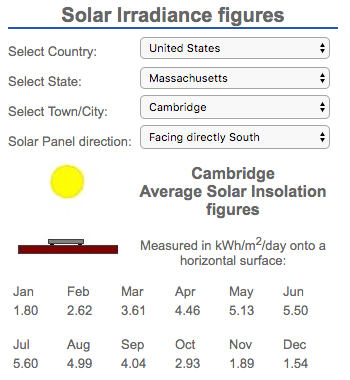
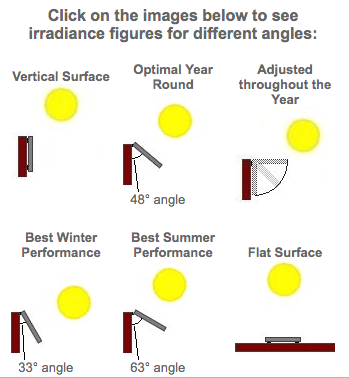 We shall see below the reduction in winter is a combination of the spreading our of the sun's rays by the projection affect and the greater absorption of solar energy as the rays travel through the atmosphere at a low slanting angle when compared to the summer sun near overhead in the sky.
We shall see below the reduction in winter is a combination of the spreading our of the sun's rays by the projection affect and the greater absorption of solar energy as the rays travel through the atmosphere at a low slanting angle when compared to the summer sun near overhead in the sky.
The Best Solar Panel Angle
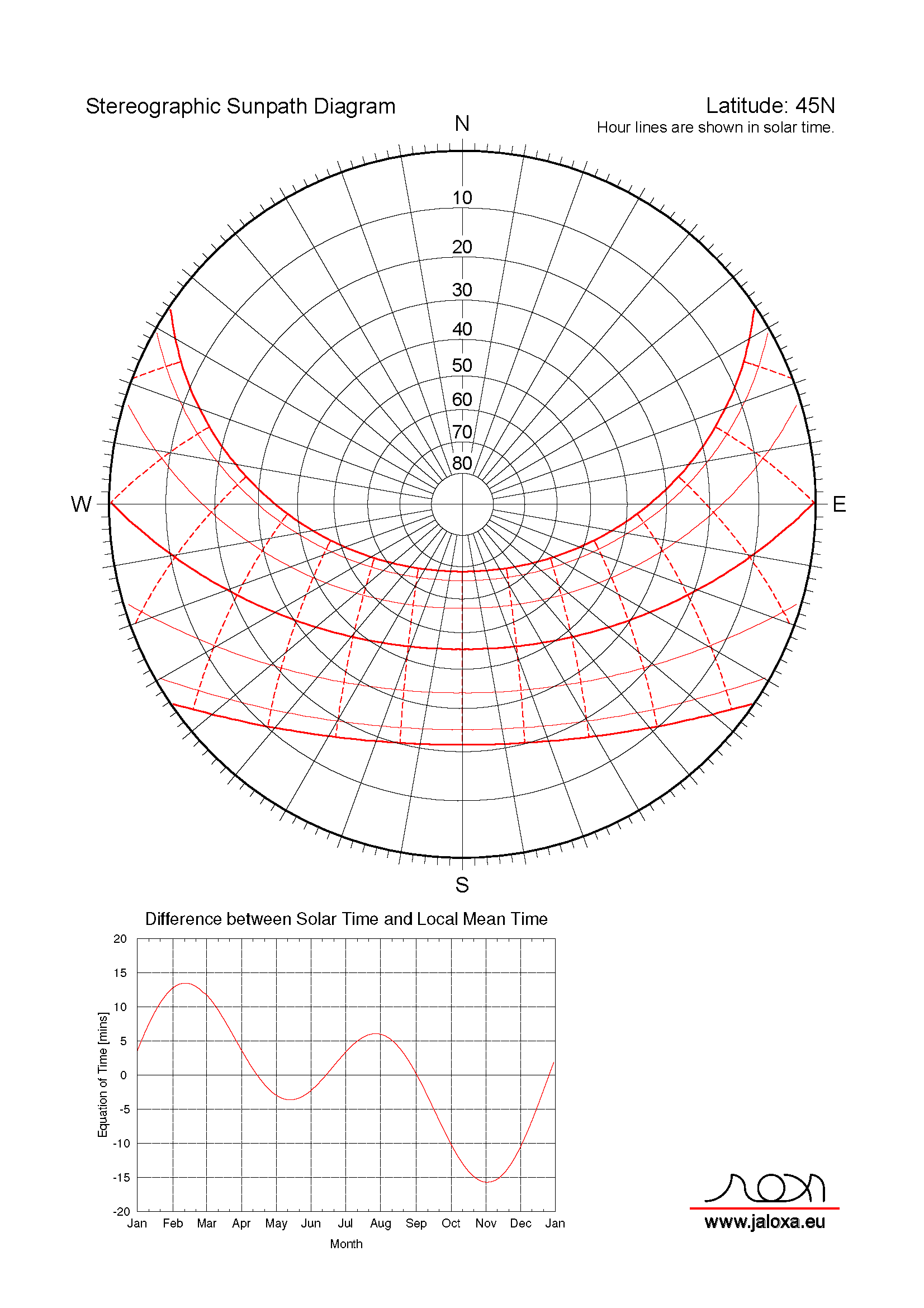 Right click to open in a new browser tab.
Right click to open in a new browser tab.
The Major Factors
Experimental Measurements
We can experimentally confirm the reduction in solar irradiance when the sun is at various angles with a white card and an inexpensive light meter.
We can confirm the power output of a PV panel at various angles to the sun with an inexpensive voltmeter and ammeter.
We can separate the production by direct sunlight from indirect scattered light with a board as large as the panel admitting only rays from the sun at a low elevation.
We can analyze shading by panels using 3D capabilities of the solar installers' software. We purchased both Aurora and Helioscope for this study.
We will ask solar panel manufacturers to loan us test panels, but will purchase leading solar panels if necessary.
Questions
Can solar panel software analysis tools tell us the power generated by an array of panels at different times of day? If they cannot, how can we believe their monthly averages?
Which of the major factors above reducing energy production are included in the algorithms of analysis software?
Sample Results
We began by modeling 47 panels (LG NeON 2 390W 72 Cell Mono 1500V SLV/WHT BiFacial Solar Panel, LG390N2T-A5) to the flat roof of our Information Philosophy Institute.
We oriented the panels due south and tilted them to four different angles - 47° (our latitude), 18°, 10°, and 0° (flat on the roof).
Helioscope software estimated the power output as 18.3 kW and generated the following monthly values for energy production.
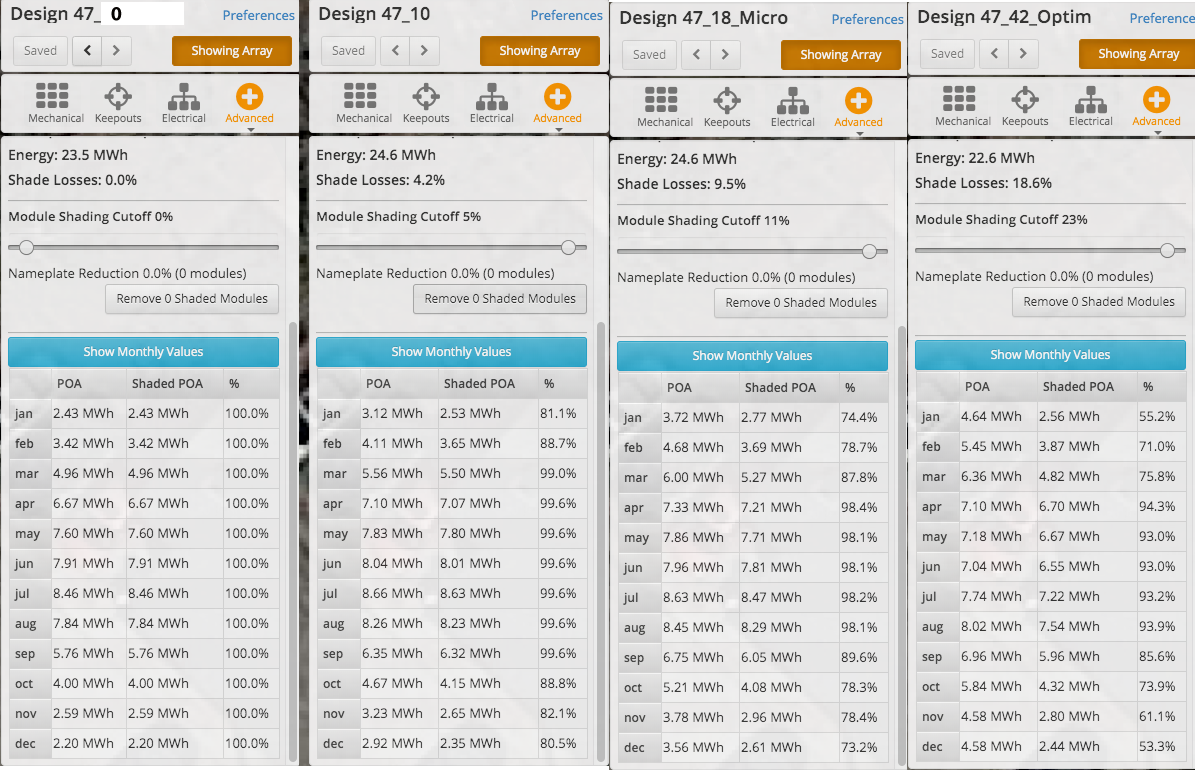 Right click to open in a new browser tab.
We can see that panels flat on the roof have no shading losses, where those tilted at latitude lose 18.6% .
We can use Aurora to visualize that shading at different times of day. The panels are separated enough to eliminate shading of a panel directly behind, but only at solar noon. At other times the shadow angles down to the sides, cutting off power from panels diagonally behind.
We again arranged 47 LG bifacial panels on the roof by using 1" panel spacing and 24" spacing between rows. Aurora also estimated power at 18.3 kW.
They are probably just multiplying 47 panels times 390W per panel! And the figure of 390W is when the LG bifacial is illuminated with 1000 W/m2, which is not achievable with panels in typical conditions.
Right click to open in a new browser tab.
We can see that panels flat on the roof have no shading losses, where those tilted at latitude lose 18.6% .
We can use Aurora to visualize that shading at different times of day. The panels are separated enough to eliminate shading of a panel directly behind, but only at solar noon. At other times the shadow angles down to the sides, cutting off power from panels diagonally behind.
We again arranged 47 LG bifacial panels on the roof by using 1" panel spacing and 24" spacing between rows. Aurora also estimated power at 18.3 kW.
They are probably just multiplying 47 panels times 390W per panel! And the figure of 390W is when the LG bifacial is illuminated with 1000 W/m2, which is not achievable with panels in typical conditions.
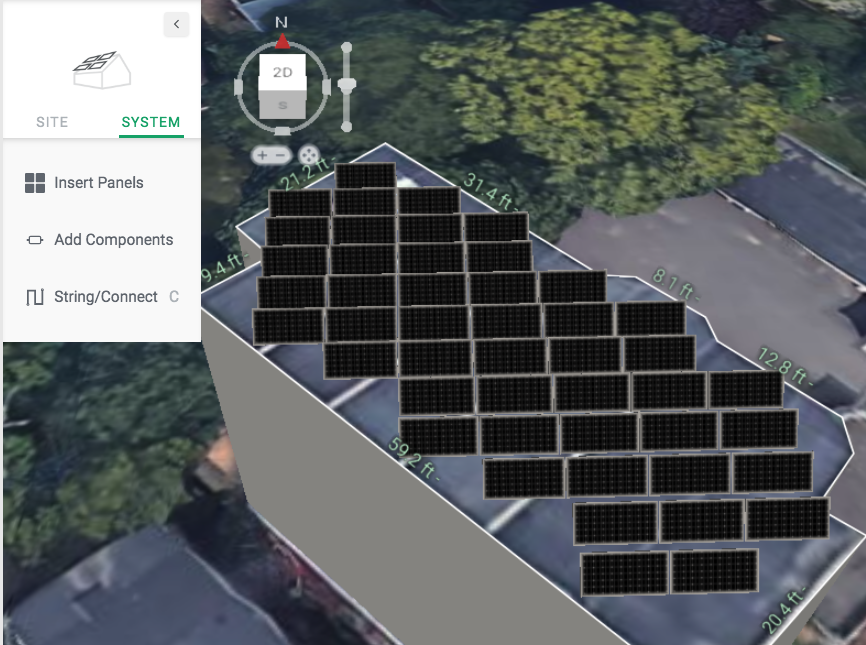 When we look down from our latitude angle, we see that there is no panel shading. Aurora's camera view point is not very far above the roof. To show panel shading from the sun's POV it should be infinitely far away. So panels at the rear appear to be shading because of their perspective.
We can now rotate Aurora to see the panels from the east at the summer solstice, when the sun is 35° above the horizon and producing a bit under half the solar irradiance at its maximum for the day.
When we look down from our latitude angle, we see that there is no panel shading. Aurora's camera view point is not very far above the roof. To show panel shading from the sun's POV it should be infinitely far away. So panels at the rear appear to be shading because of their perspective.
We can now rotate Aurora to see the panels from the east at the summer solstice, when the sun is 35° above the horizon and producing a bit under half the solar irradiance at its maximum for the day.
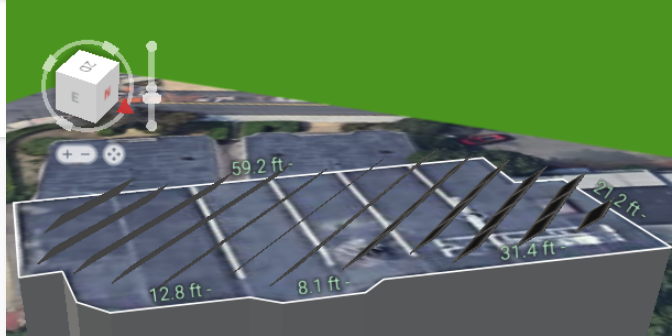 From the east, the panels are not facing the sun, but are edge on. The near perspective again diverges from the sun's perspective. The point is that instead of nearly half power, there is no power. It's not clear whether the Aurora irradiance (or "solar access value) gives us this reduction.
From the east, the panels are not facing the sun, but are edge on. The near perspective again diverges from the sun's perspective. The point is that instead of nearly half power, there is no power. It's not clear whether the Aurora irradiance (or "solar access value) gives us this reduction.
Shading in Aurora
On the flat unshaded part of the roof solar access is 100% and the irradiance is 1410 kWh/m2/yr.
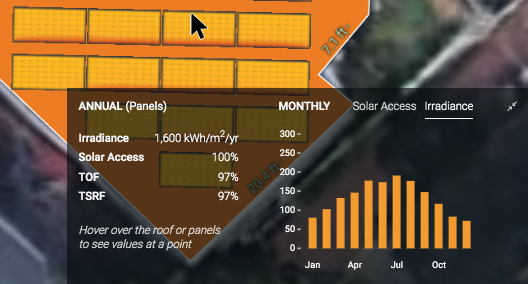 When the cursor is on the unshaded portion of a panel tilted at 20° the solar access is 100% and the irradiance increases to 1610 kWh/m2/yr. A panel that was tilted to face the sun directly would have still higher irradiance. Aurora shows the monthly variation in irradiance.
When the cursor is on the unshaded portion of a panel tilted at 20° the solar access is 100% and the irradiance increases to 1610 kWh/m2/yr. A panel that was tilted to face the sun directly would have still higher irradiance. Aurora shows the monthly variation in irradiance.
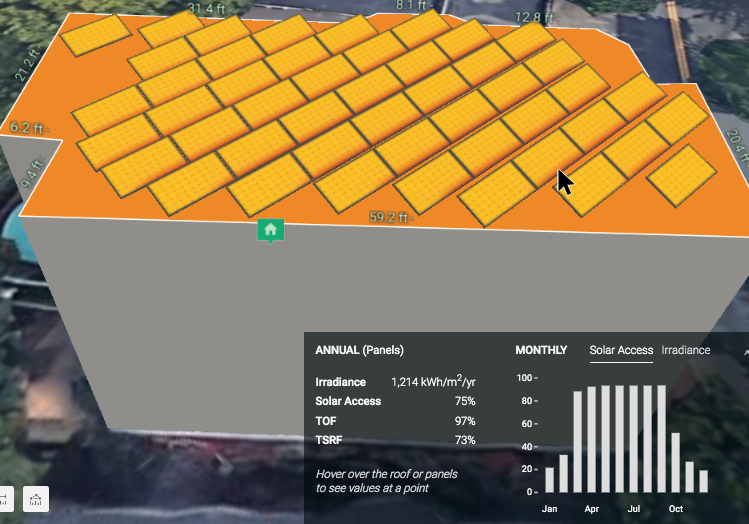 Aurora shows the shading on a panel as the color changing from bright yellow to a dark purple. Above the cursor is on the shaded portion of a panel. Solar access averages only 75% and is way down in the winter months. Shading reduces irradiance to 1214 kWh/m2/yr.
Normal | Teacher | Scholar
Aurora shows the shading on a panel as the color changing from bright yellow to a dark purple. Above the cursor is on the shaded portion of a panel. Solar access averages only 75% and is way down in the winter months. Shading reduces irradiance to 1214 kWh/m2/yr.
Normal | Teacher | Scholar
|